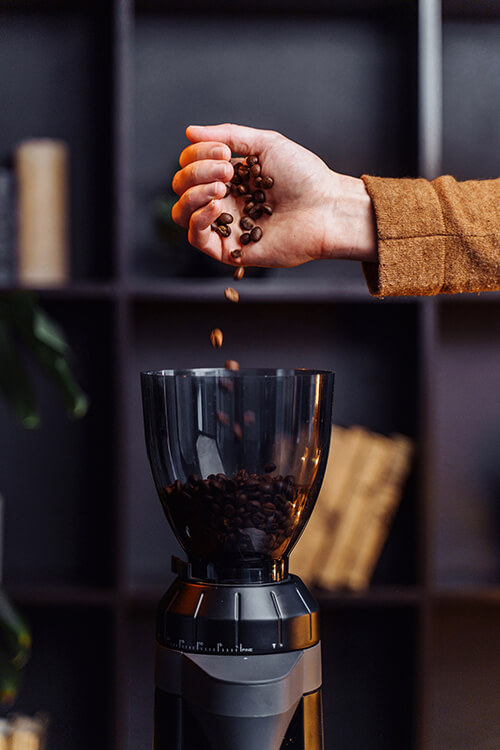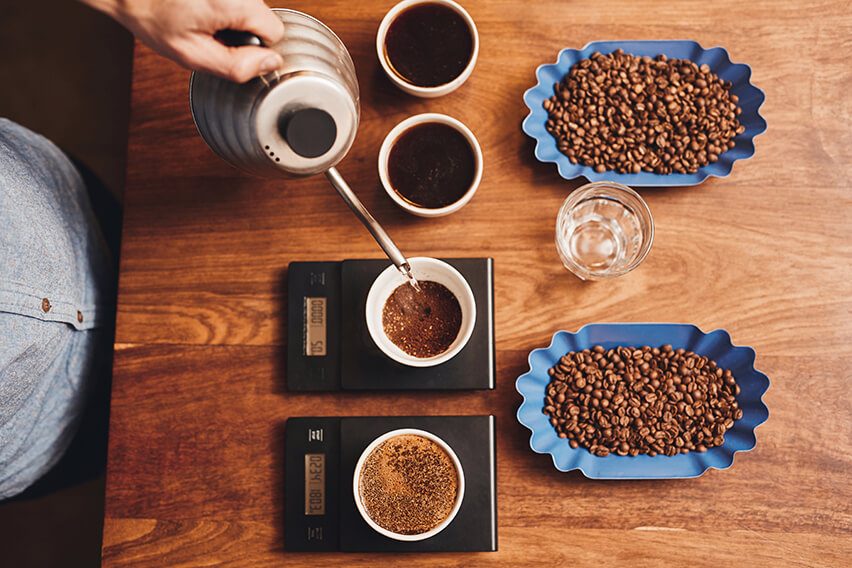The most repeated point in any discussion on preparing coffee – whether it was espresso or filter coffee, or it was for a specialty café or home – is the importance of the coffee grinder. It is not just deemed as important, but it's the most important appliance of all machines – even more important than the espresso machine itself.
The main job of an espresso machine is to push water through ground coffee with 9 bars and at a stable temperature. Everything else is considered to be additions that enhance the control over the process and increase the machine’s ability to extract the coffee in a different way in order to achieve a distinct result and taste with the same coffee beans. The quality of espresso and filter coffee depends on the grinding quality of the coffee grinder. If the grinding is good, it will taste smooth and delicious, but if it was bad, there is no way to repair the damage incurred by inconsistent grinding. Choosing high-quality grinders that produce consistent grinding is not difficult, as there are many choices available in the market. All it takes is to search for what fulfills the needs of your café.
One question remains which is whether you will need only one grinder for espresso and another for filter coffee to cover the basic needs of the café?
Two grinders – one for espresso and the other for filter coffee can cover only the basic needs, which means that the coffee shop can serve coffee but cannot cover all customers’ needs and desires. Nowadays, customers will not ask you if you have an espresso or filtered coffee because these are just the basics. However, they’ll ask about the coffee roastery providing the coffee beans and their origin country whether it is Ethiopia, Colombia, Costa Rica, or elsewhere. The customer searches for specific sources and exact processes, so depending on certain coffee beans may limit customer visits to the café.
The purpose of using different coffee grinders for different beans is not only because of the different beans. Otherwise, using a single-dose grinder for all of your coffee shop’s needs would have been an ideal option that fulfills the purpose. However, using several grinders saves time and guarantees grinding accuracy and a smaller margin of error between each different grind.

When working to meet the customer’s needs by providing various coffee origins and processes, it is necessary to think about the different grinding sizes. The grinding size of the natural process differs from the washed one, which also differs from the fermented process. Additionally, the altitude of farming land increases/decreases the density of the coffee bean, which results in a distinction in the grinding size, even if the beans were processed in the same way.
These different factors compel us to think about how to make the tasks go smoothly and ensure that the barista does not waste time adjusting the grinding size between one cup and the other. We must also be keen on reducing the margin of error when adjusting between grinds and ensure that the grind is done according to the required size for each type of coffee bean.
Using single-dose grinders better suits the home experience rather than busy businesses as you will have to adjust the grinding size for different coffee beans, which may cause a problem for your business because it affects the accuracy of the required grinding size and the consistency of quality. In addition, adjusting the grinding size takes some time, affecting your customer service speed. It is also crucial to mention the coffee ground retention in the single-dose grinders, even if they do not exceed 0.1– 0.2 grams in each grind. Therefore, if you decided to use such a grinder in your café and grind different types of coffee beans for their better quality and consistency, you must not ignore the mixing of the leftover coffee with the freshly ground coffee beans which may affect the quality of your cup of coffee.
Filter coffee can be prepared by different methods!

Filter coffee is mainly mentioned in passing, but it is not only one type of filter coffee. In fact, there is a whole category that includes many tools that prepare coffee with different results. The most famous of these classic tools are the Hario V60, Chemex, Aeropress, Clever, and Kalita. All these tools use different filters with different thicknesses which in turn alter the rate at which the coffee passes through them. Therefore, it is necessary to adjust the grinding size between fine and coarse when using these different tools. There are also new tools that use classic filters, but with a different design that allows for less extraction time, such as the Orea V3 and April, as well as tools that depend on their pores such as the Luca stone tool. With all of them, you need to adjust the grinding size and consider the speed of water flow to prepare a balanced cup of coffee.
With the rise of specialty coffee shops at the beginning of 2015, sweetened coffee drinks were the best-selling. However, over the years, the general local taste changed, and black coffee “filter coffee” became best-selling. Hence, it became important to pay more attention to how to prepare it accurately and consistently every time. This significantly depends on the grind consistency, the amount of coffee leftover from previous grinding, and the temperature stability of the grinding burrs during the consecutive grinding.
the new trend to extract espresso coffee under a different pressure
The Specialty Coffee Association considers 9 bars as the ideal pressure for extracting coffee. For many years, the standard of quality has been the stability of the extraction pressure as recommended.
But over the past few years, more experiments were conducted with different pressure profiles. for example, extracting under a pressure of 6 bar or applying variable pressure during extraction, which means starting with 3 bar, for example, then moving to a pressure of 9 bar and ending at 6 bar. Such experiments are not certified, but they can give us amazing results.
Dealing with different variables of extraction pressure makes us think again about the fineness of the espresso grind for variable extraction. There are many coffee shops that choose constant pressure, but with a long pre-infusion that may last for 30 seconds or more, which requires a finer grind than usual, while the pre-infusion usually does not exceed 8 seconds.
What makes us call this trend an experiment or attempt is that its results are not necessarily consistent with all crops, as it may produce wonderful results with certain crops and unacceptable results with others. For that reason, coffee shops interested in variable pressure choose specific crops for this type of extraction, mostly premium crops, to offer the customer a unique experience with their own touch as a different option from the 'traditional' 9-bar-extraction espresso cup.
The increasing number of coffee shops and the intensified competitiveness requires the existence of a competitive factor that helps you to be the first destination among all coffee shops. A cup of coffee is a main factor whether it was espresso, a milk-based drink, or filter coffee prepared by one of the many different preparation methods. Depending on a single grinder for all types decreases productivity, increases the margin of error when moving between different grinds of variable crops, and affects the quality consistency and customer’s expectations through his/her recurrent visits. Always be ready for what the customers expect and offer them more than what they ask for in order to be their first choice. We do not ask you to just increase the number of coffee grinders randomly, but we ask you to set a goal for your café and prepare it for what this trend requires in terms of fulfilling the requirements of the beverage menu, and being ready for any changes in the market and local taste.
Looking for the high-precision equipment that you need to do your coffee justice?
Contact us for free advice on the full range of coffee equipment and accessories that every specialty cafe needs.
REQUEST FREE CONSULTATION
